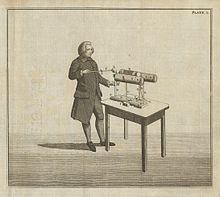Edward Nairne
Edward Nairne (* 1726 in Sandwich , England; † September 1, 1806 in London ) was an optician, instrument maker and discoverer of the eraser .
From 1741 he started his apprenticeship with the optician Matthew Loft and after his death in 1748 he founded his own shop for optical and mathematical instruments in 20 Cornhill, London. In 1774 he entered into a partnership with Thomas Blunt, who had been trained by him. In 1793, Blunt opened his own shop in the immediate vicinity at 22 Cornhill.
Edward Nairne patented some electrical devices, such as an electrostatic generator . This was planned for medical use and was touted against a variety of diseases.
Using wire explosions, he demonstrated experimentally that electrical current in a circuit of series connections is the same everywhere. He also built a portable suitcase microscope .
Around 1758 he made sets of magnets and telescopes for Benjamin Franklin . At his intercession, after the Harvard College fire in 1764 , Nairne was selected as one of the mechanics to replace the equipment.
In 1770 he discovered that pencil lines can be erased with rubber . He'd accidentally reached for it instead of the usual lump of bread used for erasing . He named it "Rubber" and sold it for the astonishingly high price of 3 shillings. The London-based instrument maker and chemist Joseph Priestley made the rubber public in the same year, which is why he is occasionally called an inventor.
In the early 1770s he constructed the first successful marine barometer in which he had narrowed the glass tube below the scale.
In 1772 he designed an electric machine based on the instructions of Joseph Priestley.
In 1776 he became a member of the Royal Society , in 1800 a member of the Royal Institution.
The Hamburg businessman and Senator Nicolaus Anton Johann Kirchhof had numerous devices in his physical cabinet made by Edward Nairne.
Individual evidence
- ↑ Electrostatic generator
- ^ Peter Heinrich Christoph Brodhagen , Friedrich Johann Lorenz Meyer: Physikalisches Kabinett of the late Senator Kirchhoff zu Hamburg , pp. 27–45, ( online. )
| personal data | |
|---|---|
| SURNAME | Nairne, Edward |
| BRIEF DESCRIPTION | English optician, instrument maker and discoverer of the eraser |
| DATE OF BIRTH | 1726 |
| PLACE OF BIRTH | Sandwich , England |
| DATE OF DEATH | September 1, 1806 |
| Place of death | London |
